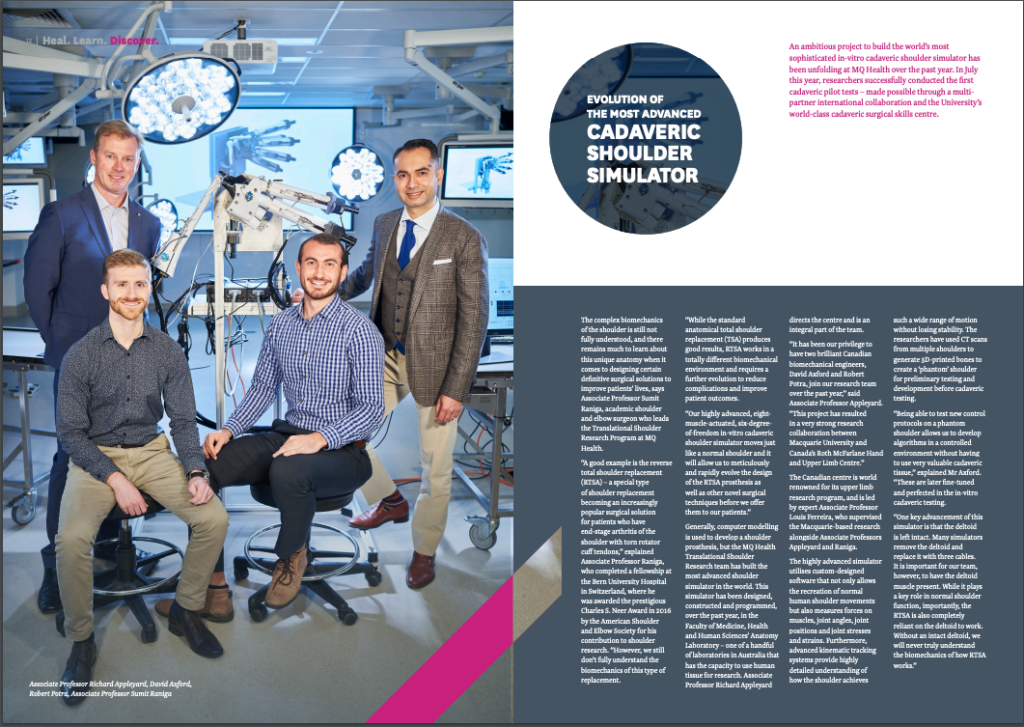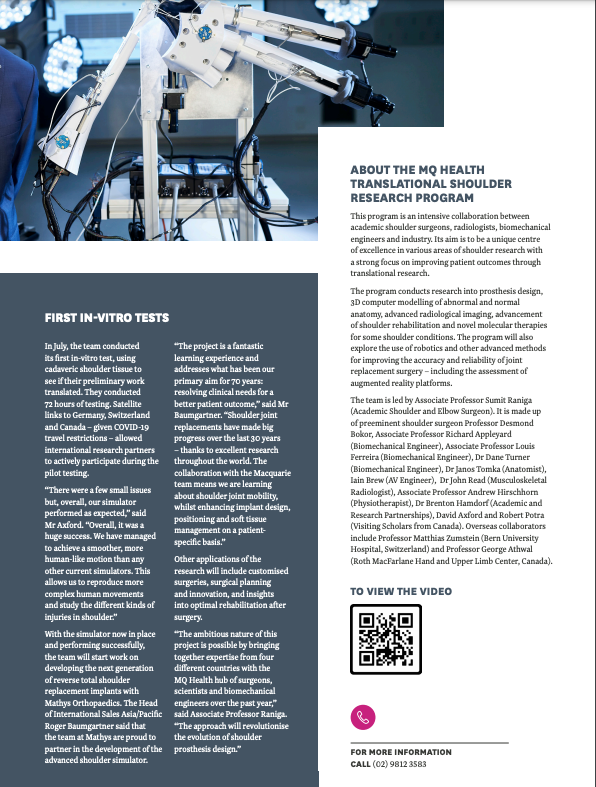An ambitious project to build the world’s most sophisticated in-vitro cadaveric shoulder simulator has been unfolding at MQ Health over the past year. In July this year, researchers successfully conducted the first cadaveric pilot tests – made possible through a multipartner international collaboration and the University’s world-class cadaveric surgical skills centre.
The complex biomechanics of the shoulder is still not fully understood, and there remains much to learn about this unique anatomy when it comes to designing certain definitive surgical solutions to improve patients’ lives, says Associate Professor Sumit Raniga, academic shoulder and elbow surgeon who leads the Translational Shoulder Research Program at MQ Health.
“A good example is the reverse total shoulder replacement (RTSA) – a special type of shoulder replacement becoming an increasingly popular surgical solution for patients who have end-stage arthritis of the shoulder with torn rotator cuff tendons,” explained Associate Professor Raniga, who completed a fellowship at the Bern University Hospital in Switzerland, where he was awarded the prestigious Charles S. Neer Award in 2016 by the American Shoulder and Elbow Society for his contribution to shoulder research. “However, we still don’t fully understand the biomechanics of this type of replacement.
“While the standard anatomical total shoulder replacement (TSA) produces good results, RTSA works in a totally different biomechanical environment and requires a further evolution to reduce complications and improve patient outcomes.
“Our highly advanced, eightmuscle-actuated, six-degreeof-freedom in-vitro cadaveric shoulder simulator moves just like a normal shoulder and it will allow us to meticulously and rapidly evolve the design of the RTSA prosthesis as well as other novel surgical techniques before we offer them to our patients.”
Generally, computer modelling is used to develop a shoulder prosthesis, but the MQ Health Translational Shoulder Research team has built the most advanced shoulder simulator in the world. This simulator has been designed, constructed and programmed, over the past year, in the Faculty of Medicine, Health and Human Sciences’ Anatomy Laboratory – one of a handful of laboratories in Australia that has the capacity to use human tissue for research. Associate Professor Richard Appleyard directs the centre and is an integral part of the team.
“It has been our privilege to have two brilliant Canadian biomechanical engineers, David Axford and Robert Potra, join our research team over the past year,” said Associate Professor Appleyard. “This project has resulted in a very strong research collaboration between Macquarie University and Canada’s Roth McFarlane Hand and Upper Limb Centre.”
The Canadian centre is world renowned for its upper limb research program, and is led by expert Associate Professor Louis Ferreira, who supervised the Macquarie-based research alongside Associate Professors Appleyard and Raniga.
The highly advanced simulator utilises custom-designed software that not only allows the recreation of normal human shoulder movements but also measures forces on muscles, joint angles, joint positions and joint stresses and strains. Furthermore, advanced kinematic tracking systems provide highly detailed understanding of how the shoulder achieves such a wide range of motion without losing stability. The researchers have used CT scans from multiple shoulders to generate 3D-printed bones to create a ‘phantom’ shoulder for preliminary testing and development before cadaveric testing.
“Being able to test new control protocols on a phantom shoulder allows us to develop algorithms in a controlled environment without having to use very valuable cadaveric tissue,” explained Mr Axford. “These are later fine-tuned and perfected in the in-vitro cadaveric testing.
“One key advancement of this simulator is that the deltoid is left intact. Many simulators remove the deltoid and replace it with three cables. It is important for our team, however, to have the deltoid muscle present. While it plays a key role in normal shoulder function, importantly, the RTSA is also completely reliant on the deltoid to work. Without an intact deltoid, we will never truly understand the biomechanics of how RTSA works.”
FIRST IN-VITRO TESTS
In July, the team conducted its first in-vitro test, using cadaveric shoulder tissue to see if their preliminary work translated. They conducted 72 hours of testing. Satellite links to Germany, Switzerland and Canada – given COVID-19 travel restrictions – allowed international research partners to actively participate during the pilot testing.
“There were a few small issues but, overall, our simulator performed as expected,” said Mr Axford. “Overall, it was a huge success. We have managed to achieve a smoother, more human-like motion than any other current simulators. This allows us to reproduce more complex human movements and study the different kinds of injuries in shoulder.”
With the simulator now in place and performing successfully, the team will start work on developing the next generation of reverse total shoulder replacement implants with Mathys Orthopaedics. The Head of International Sales Asia/Pacific Roger Baumgartner said that the team at Mathys are proud to partner in the development of the advanced shoulder simulator.
“The project is a fantastic learning experience and addresses what has been our primary aim for 70 years: resolving clinical needs for a better patient outcome,” said Mr Baumgartner. “Shoulder joint replacements have made big progress over the last 30 years – thanks to excellent research throughout the world. The collaboration with the Macquarie team means we are learning about shoulder joint mobility, whilst enhancing implant design, positioning and soft tissue management on a patient specific basis.”
Other applications of the research will include customised surgeries, surgical planning and innovation, and insights into optimal rehabilitation after surgery.
“The ambitious nature of this project is possible by bringing together expertise from four different countries with the MQ Health hub of surgeons, scientists and biomechanical engineers over the past year,” said Associate Professor Raniga. “The approach will revolutionise the evolution of shoulder prosthesis design.”
ABOUT THE MQ HEALTH TRANSLATIONAL SHOULDER RESEARCH PROGRAM
This program is an intensive collaboration between academic shoulder surgeons, radiologists, biomechanical engineers and industry. Its aim is to be a unique centre of excellence in various areas of shoulder research with a strong focus on improving patient outcomes through translational research.
The program conducts research into prosthesis design, 3D computer modelling of abnormal and normal anatomy, advanced radiological imaging, advancement of shoulder rehabilitation and novel molecular therapies for some shoulder conditions. The program will also explore the use of robotics and other advanced methods for improving the accuracy and reliability of joint replacement surgery – including the assessment of augmented reality platforms.
The team is led by Associate Professor Sumit Raniga (Academic Shoulder and Elbow Surgeon). It is made up of preeminent shoulder surgeon Professor Desmond Bokor, Associate Professor Richard Appleyard (Biomechanical Engineer), Associate Professor Louis Ferreira (Biomechanical Engineer), Dr Dane Turner (Biomechanical Engineer), Dr Janos Tomka (Anatomist), Iain Brew (AV Engineer), Dr John Read (Musculoskeletal Radiologist), Associate Professor Andrew Hirschhorn (Physiotherapist), Dr Brenton Hamdorf (Academic and Research Partnerships), David Axford and Robert Potra (Visiting Scholars from Canada). Overseas collaborators include Professor Matthias Zumstein (Bern University Hospital, Switzerland) and Professor George Athwal (Roth MacFarlane Hand and Upper Limb Center, Canada).
MQ Health Shoulder and Elbow Clinic,
Suite 303, Level 3,
2 Technology Place,
Macquarie University
NSW 2109
Australia


